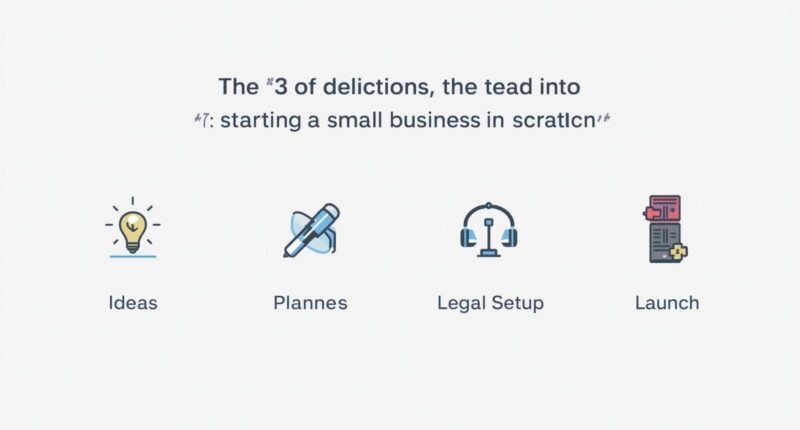How to Start a Small Business from Scratch
Turning Your Passion into Profit
Starting a small business from scratch is one of the most exciting — and challenging — journeys you can take.
It’s about transforming your ideas, passions, and skills into a sustainable source of income and independence.
Whether you want to open a café, start an online shop, or launch a digital service brand, this guide will walk you through how to start a small business from scratch — step by step — with real strategies to help you succeed, grow, and stay financially confident.
Why Starting a Small Business Is the Smartest Move Today
In a world driven by economic uncertainty and automation, entrepreneurship offers freedom and opportunity that traditional jobs often can’t.
Key Benefits of Starting a Small Business
-
Control over your income and time
-
Opportunity to build wealth and personal brand
-
Freedom to pursue your passions
-
Ability to make a direct impact in your community
The digital era has made it easier than ever to start small, grow fast, and scale globally — even from home.
Table – Essential Stages of Building a Small Business from Scratch
| Stage | Description | Goal |
|---|---|---|
| 1. Idea Validation | Research and confirm market demand | Ensure profitability |
| 2. Business Planning | Set goals, budgets, and strategies | Create a clear roadmap |
| 3. Legal Setup | Register and structure your business | Stay compliant and credible |
| 4. Branding | Build your name, logo, and identity | Stand out and attract customers |
| 5. Marketing & Sales | Promote products or services effectively | Generate consistent revenue |
| 6. Scaling | Automate, delegate, and expand | Grow sustainably and efficiently |
Each stage builds a foundation for long-term success and financial freedom.
Step 1 – Validate Your Business Idea
Every great business starts with a great idea — but not all ideas are profitable.
Before investing time or money, confirm that your product or service solves a real problem for real people.
How to Validate Your Idea
-
Conduct surveys or interviews with potential customers
-
Study competitors — what they do well and where they fail
-
Test with a small product sample or free trial
-
Check online demand through Google Trends or social media
Validation saves you from building something people don’t actually need.
For more insight on aligning money with purpose, read How to Design a Wealth-Focused Lifestyle That Lasts.
Step 2 – Write a Simple, Effective Business Plan
A solid business plan doesn’t need to be 100 pages long.
It should clearly explain what you’re building, why, and how it will make money.
Your Business Plan Should Include
-
Mission Statement: Why your business exists.
-
Target Market: Who your ideal customers are.
-
Product/Service Description: What you’re offering and why it’s unique.
-
Revenue Model: How you’ll earn income (sales, subscriptions, etc.).
-
Startup Budget: Estimate initial costs and funding sources.
-
Marketing Plan: How you’ll attract and retain customers.
-
Growth Goals: 6-month, 1-year, and 3-year milestones.
A clear plan gives direction — and attracts investors or partners if needed.
Step 3 – Choose the Right Business Structure
Choosing your business structure affects your taxes, legal protection, and daily operations.
Popular Small Business Structures
-
Sole Proprietorship: Simple and affordable but offers no liability protection.
-
LLC (Limited Liability Company): Protects personal assets and offers flexibility.
-
Partnership: Shared ownership with defined responsibilities.
-
Corporation: Complex setup but ideal for larger-scale growth.
If you’re unsure, start with an LLC for legal safety and credibility.
Check the U.S. Small Business Administration’s Official Business Structure Guide for detailed comparisons.
Step 4 – Register Your Business and Obtain Permits
Once you’ve chosen a structure, register your business name and obtain the required permits.
Essential Steps
-
Register your business name with your state or country.
-
Apply for an Employer Identification Number (EIN).
-
Check for local business licenses or health permits.
-
Open a separate business bank account.
Separating personal and business finances is critical to maintain clear accounting and tax records.
Step 5 – Build a Strong Brand Identity
Branding isn’t just about a logo — it’s about reputation, emotion, and trust.
Branding Components
-
Business Name: Memorable and relevant to your niche.
-
Logo & Color Scheme: Consistent across all platforms.
-
Website & Domain: Your online headquarters.
-
Tagline & Mission: What your brand stands for.
Your brand tells your story — it’s how customers recognize and remember you.
Step 6 – Plan Your Finances and Funding
Money is the engine that powers your business.
Even if you’re starting small, plan your cash flow and funding sources.
Funding Options
-
Personal savings
-
Family/friends investment
-
Crowdfunding (Kickstarter, GoFundMe)
-
Small business loans or grants
-
Angel investors or venture capital
Budget Tips
-
Keep fixed costs low at the beginning.
-
Reinvest profits instead of overspending.
-
Track every expense using accounting software like QuickBooks or Wave.
Smart financial management ensures your business stays profitable and sustainable.
Step 7 – Develop Your Product or Service
Your offer must solve a problem, save time, or create joy.
For Product-Based Businesses
-
Source reliable suppliers.
-
Test prototypes for quality assurance.
-
Set competitive pricing strategies.
For Service-Based Businesses
-
Define your packages or hourly rates.
-
Showcase testimonials or portfolio samples.
-
Automate bookings and client communication.
A well-developed product or service creates trust, loyalty, and referrals.
Step 8 – Build an Online Presence
In today’s world, digital visibility = business credibility.
Steps to Build an Online Presence
-
Create a professional website (WordPress or Shopify).
-
Add essential pages: Home, About, Services, Blog, and Contact.
-
Optimize for SEO — use keywords naturally throughout content.
-
Create social media profiles (Facebook, Instagram, LinkedIn).
-
Post consistently to build authority and engagement.
Your website acts as your 24/7 marketing machine, attracting potential customers even while you sleep.
Step 9 – Market and Promote Your Business
A great product means nothing if no one knows about it.
Use digital and traditional marketing to attract attention and generate sales.
Powerful Marketing Techniques
-
Content marketing (blogs, videos, podcasts)
-
Social media ads and influencer collaborations
-
Email marketing with special offers
-
Google My Business listings for local reach
-
Networking at local events or trade fairs
Consistent marketing builds brand awareness and steady revenue streams.
Step 10 – Build Customer Trust and Retention
Customer trust is the heart of long-term success.
Happy clients return — and bring referrals.
Trust-Building Strategies
-
Provide exceptional customer service.
-
Communicate transparently.
-
Deliver on time and exceed expectations.
-
Request and display testimonials.
When customers trust your business, marketing becomes easier and cheaper.
Step 11 – Automate and Optimize
Automation saves time, reduces stress, and helps scale your operations smoothly.
Automation Tools
-
Email: Use tools like Mailchimp or ConvertKit.
-
Invoicing: Automate with PayPal, Stripe, or QuickBooks.
-
Social Media: Schedule posts with Buffer or Later.
-
CRM Systems: Manage customer relationships effectively.
Automation frees up your time so you can focus on innovation and expansion.
Step 12 – Track Progress and Adjust Strategy
Regularly reviewing your results helps you identify what’s working — and what isn’t.
Key Metrics to Track
-
Sales and profit growth
-
Website traffic and conversion rate
-
Customer satisfaction scores
-
Advertising ROI (Return on Investment)
Use analytics to make data-driven decisions instead of emotional ones.
Step 13 – Network and Keep Learning
Business growth depends on your willingness to connect and evolve.
Growth Practices
-
Join local business associations.
-
Attend entrepreneurship workshops or webinars.
-
Follow industry leaders and mentors.
-
Read books on marketing, finance, and leadership.
The more you learn, the more adaptable and innovative your business becomes.
Step 14 – Scale and Expand Your Business
Once you have consistent profit, it’s time to grow strategically.
Scaling Options
-
Add new products or services.
-
Expand into new markets or locations.
-
Hire a small team or outsource tasks.
-
Increase marketing investments.
Scaling transforms your small business into a sustainable brand with long-term financial potential.
Step 15 – Stay Resilient and Future-Focused
Challenges are inevitable, but resilience separates successful entrepreneurs from the rest.
Stay Motivated By
-
Remembering your “why.”
-
Celebrating small milestones.
-
Learning from mistakes instead of fearing them.
-
Maintaining balance — your health is your real wealth.
Consistency, passion, and adaptability are the keys to building a business that lasts.
Conclusion: Your Dream Business Starts with One Step
Starting a small business from scratch doesn’t require perfection — only commitment.
With the right mindset, planning, and persistence, you can transform your ideas into income, and your dreams into a lasting enterprise.
Every entrepreneur starts small. What matters most is that you start now, stay disciplined, and keep learning along the way.
Remember — success is built one decision, one customer, and one day at a time.









